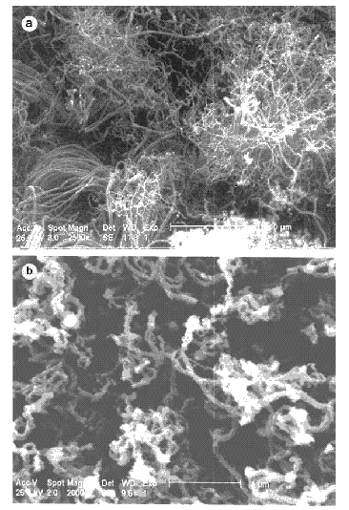SKEDSOFT
Buckyballs: By far the most popular discovery in nanotechnology is the Buckminsterfullerene molecules. Buckminsterfullerene (or fullerene), C60, as is shown in Figure 6 is another allotrope of carbon (after graphite and diamond), which was discovered in 1985 by Kroto and collaborators. These investigators used laser evaporation of graphite and they found Cn clusters (with n>20 and even-numbers) of which the most common were found to be C60 and C70. For this discovery by Curl, Kroto and Smalley were awarded the 1996 Nobel Prize in Chemistry. Later fullerenes with larger number of carbon atoms (C76, C80, C240, etc.) were also discovered.
Since the time of discovery of fullerenes over a decade and a half ago, a great deal of investigation has gone into these interesting and unique nanostructures. They have found tremendous applications in nanotechnology. In 1990 a more efficient and less expensive method to produce fullerenes was developed by Krätchmer and collaborators [25]. Further research on this subject to produce less expensive fullerene is in progress. Availability of low cost fullerene will pave the way forfurther research into practical applications of fullerene and its role in nanotechnology.

Figure 1. The four allotropes of carbon.
Carbon Nanotubes: Carbon nanotubes were discovered by Iijima in 1991 using an electron microscope while studying cathodic material deposition through vaporizing carbon graphite in an electric arcevaporation reactor under an inert atmosphere during the synthesis of Fullerene. The nanotubes produced by Iijima appeared to be made up of a perfect network of hexagonal graphite, Figure1, rolled up to form a hollow tube. The nanotube diameter range is from one to several nanometers which is much smaller than its length range which is from one to a few micrometers. A variety of manufacturing techniques has since been developed to synthesize and purify carbon nanotubes with tailored characteristics and functionalities. Controlled production of singlewalled carbon nanotubes is one of the favorite forms of carbon nanotube which has many present and future applications in nanoscience and nanotechnology. Laser ablation chemical vapor deposition joined with metal-catalyzed disproportionation of suitable carbonaceous feedstock are often used to produce carbon nanotubes. Figure 2 is the scanning electron microscope (SEM) images of a cluster of nanotubes recently produced through plasma enhanced chemical vapor deposition at two different temperatures. Carbon nanotubes and fullerenes are shown to exhibit unusual photochemical, electronic, thermal and mechanical properties. It is also shown that single-walled carbon nanotubes (SWCNTs) could behave metallic, semi-metallic, or semi-conductive one-dimensional objects, and their longitudinal thermal conductivity could exceed the in-plane thermal conductivity of graphite . Very high tensile
strength (~100 times that of steel) of ropes made of SWCNTs has recently been determined experimentally . When dispersed in another medium, it is demonstrated that SWCNTs could retain their intrinsic mechanical attributes or even augment the structural properties of their medium host . SWCNTs have similar electrical conductivity as copper and similar thermal conductivity as diamond.
There is a great deal of interest and activity in the present day to find applications for fullerene and carbon nanotube. There are many ongoing research activities to understand the characteristics of carbon nanotubes including their physicochemical properties, their stability and behavior under stress and strain, their interactions with other molecules and nanostructures and their utility for novel applications

Figure 2. Carbon nanotubes produced using plasma-enhanced chemical vapor deposition at various temperatures [29]. SEM images of deposited carbon nanotubes at (a) 650 oC, (b) 700 oC.